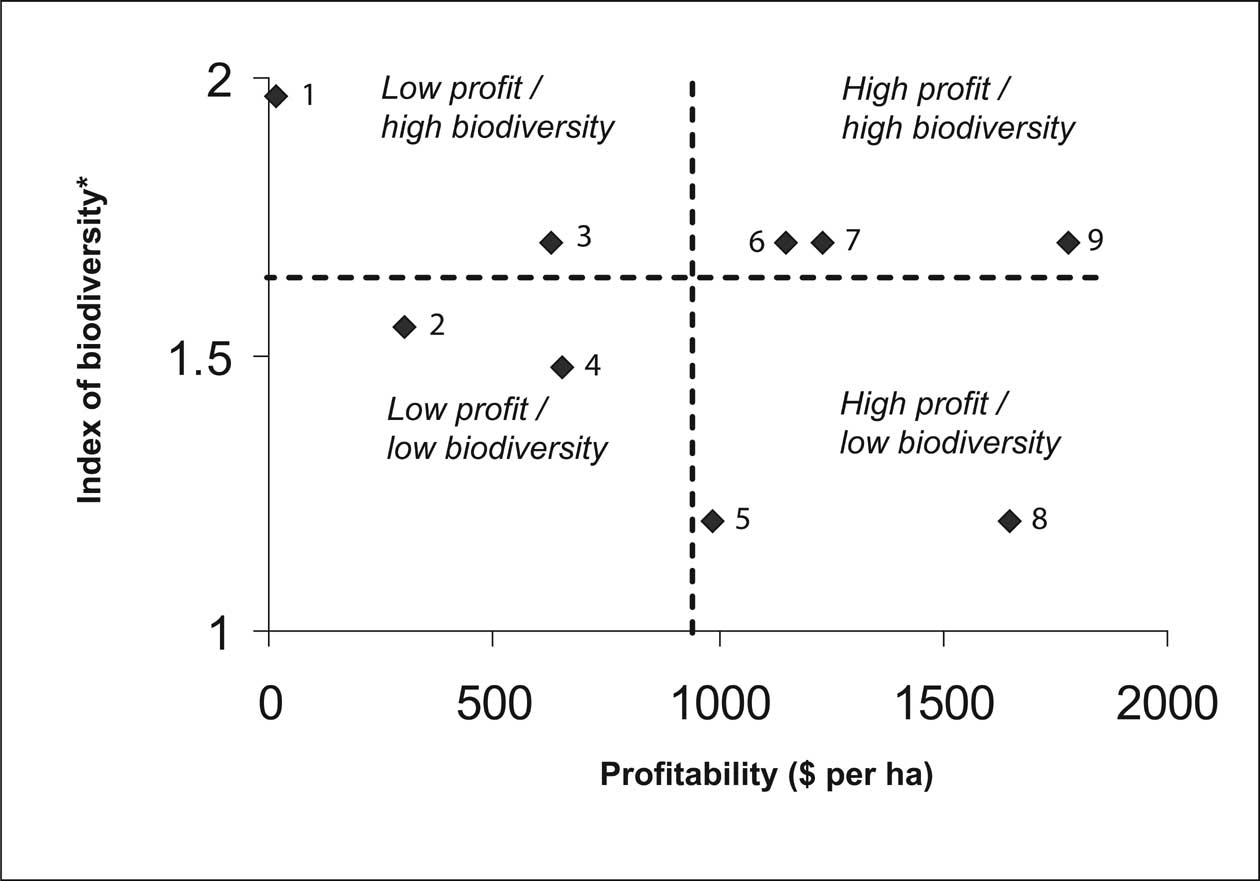With enhanced marketing they have the potential to support forest community livelihoods and increase the commercial value of natural forests, thus strengthening initiatives to promote the conservation of forests and woodlands, especially in the tropics. NTFPs can be a rich in major nutrients, minor nutrients, vitamins and minerals (Leakey, 1999a) and have the potential to provide future products for the benefit of humankind. However, future innovations based on NFTPs must recognize Traditional Knowledge, community practice/law/regulations and be subject to Access and Benefit Sharing Agreements, in accordance with the Convention on Biological Diversity (Marshall et al., 2006).
Non-timber forest products (NTFP) formerly gathered as extractive resources from natural forests are increasingly being grown in small-scale farming systems, and have become recognized as farm produce (Agroforestry Tree Products- AFTPs).
| Goals N, H, L, S |
Certainty A |
Range of 0 to +1 to +3 | Scale R |
Specificity Relevant worldwide |
Small-scale farming systems commonly include both exotic and native tree species (Schreckenberg et al., 2002, 2006; Shackleton et al., 2002; Kindt et al., 2004; Degrande et al., 2006) producing a wide range of different wood and nonwood products. Such products include traditional foods and medicines, gums, fibers, resins, extractives like rubber, and timber, which are increasingly being marketed in local, regional and international markets (Ndoye et al., 1997; Awono et al., 2002). These recent developments are generating livelihoods benefits for local communities (Degrande et al., 2006) in ways that require little investment of cash and have low labor demands. The term AFTP distinguishes these from extractive NTFP resources so that their role in food and nutritional security and in the enhancement of the livelihoods of poor farmers can be recognized in agricultural statistics (Simons and Leakey, 2004).
In the last 10 years there has been increasing investment in agroforestry programs to domesticate species producing AFTPs as new cash crops for income generation by smallscale farmers.
| Goals N, H, L, E, S |
Certainty A |
Range of Impacts Early adoption phase |
Scale M-L |
Specificity Especially relevant to wet/dry tropics |
Socially- and commercially-important herbaceous and woody species are now being domesticated as new crops to meet the needs of local people for traditional foods, medicines, other products (Okafor, 1980; Smartt and Haq, 1997; Guarino, 1997; Schippers and Budd, 1997; Sunderland et al., 1999; Schippers, 2000), and for expanded trade (Ndoye et al., 1997). Participatory domestication of AFTPs is in the early phases of adoption, especially in Africa (Tchoundjeu et al., 2006), small-scale farmers recognize the importance of producing and trading these traditional food species for domestic and wider use and the enhancement of food sovereignty. These programs are improving livelihoods at the household level (Schreckenberg et al., 2002; Degrande et al., 2006), and increasing food and nutritional security. Many of these new crops are important as sources of feed
for livestock (Bonkoungou et al., 1998), potential new markets, e.g., vegetable oils (Kapseu et al., 2002) and pharmaceuticals or nutriceuticals (Mander et al., 1996; Mander, 1998), for helping farmers meet specific income needs, e.g., school fees and uniforms (Schreckenberg et al., 2002), and for buffering the effects of price fluctuations in cocoa and other commodity crops (Gockowski and Dury, 1999). This emerging market orientation needs to be developed carefully as it potentially conflicts with community-oriented values and traditions. A series of "Winners and Losers" projects on the commercialization of NTFPs (now Agroforestry Tree Products-AFTPs) have examined these options (e.g., Leakey et al., 2005a; Marshall et al., 2006). These systems target the restoration of natural capital, the wellbeing of the resource-poor farmer and combine ecological benefits with cash generation (Leakey et al., 2005a), making them a component of a "Localization" strategy. The integration of domesticated indigenous fruit and nut trees into cocoa agroforests would further improve a land use system that is already one of the most profitable and biologically diverse systems (Figure 3-7).
Domesticated agroforestry trees are producing products that meet many of the needs of small-scale farmers and have the capacity to produce new agricultural commodities and generate new industries.
| Goals N, L |
Certainty B |
Range of Impacts +2 to +3 |
Scale L |
Specificity Mainly small-scale agriculture |
Participatory rural appraisal approaches to priority setting species selected for domestication found that indigenous fruits and nuts were the species most commonly identified by rural communities (Franzel et al., 1996). Many of these fruits and nuts are important traditional foods with

Figure 3-7. Landuse systems in the humid zone of Cameroon in terms of profitability and plant species diversity. Source: Izac and Sanchez, 2001.
* Based on field assessments
Note: (1= Community forest; 2 = Long fallow farming; 3 = Extensive cocoa farm; 4 = Short fallow farming; 5 = Short fallow oil palm; 6 = Extensive cocoa with fruits; 7 = Intensive cocoa; 8 = Forest oil palm; 9 = Intensive cocoa with fruits)